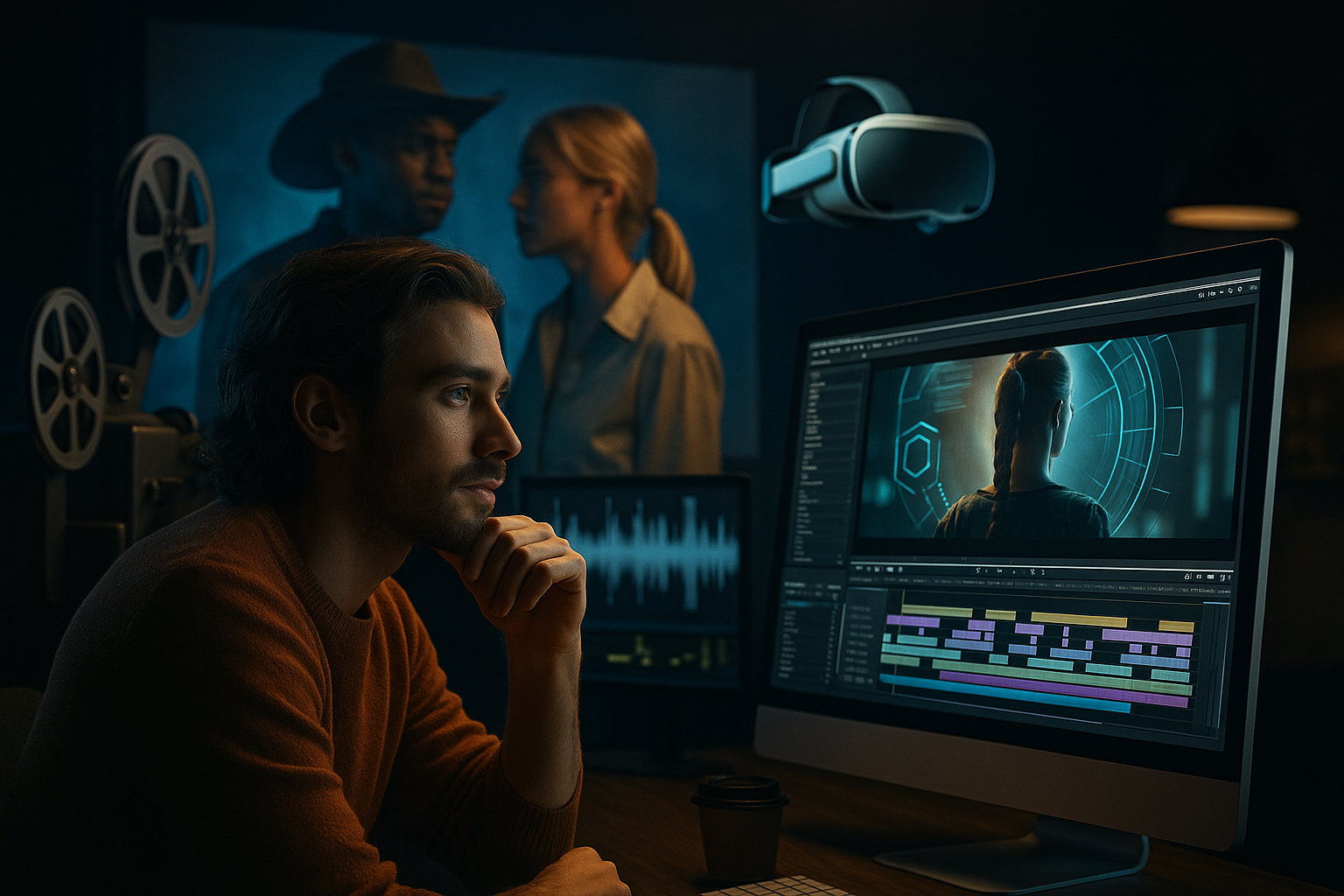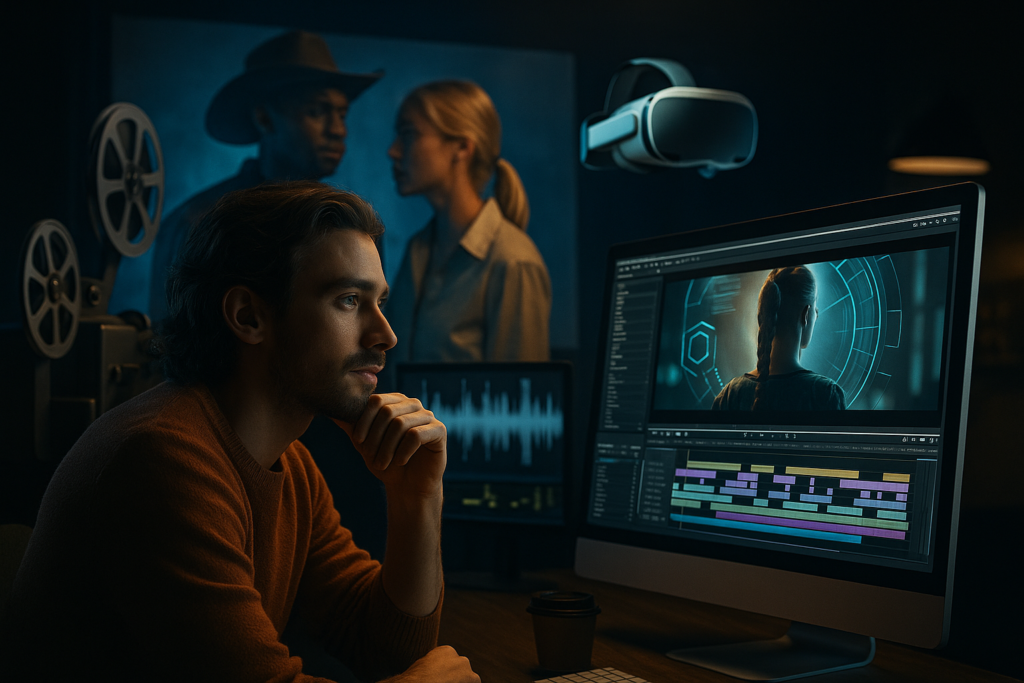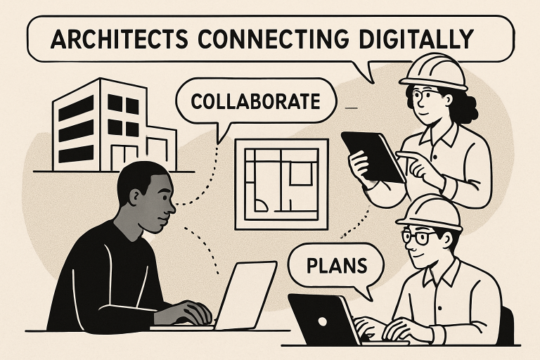Table of Contents
Introduction
Storytelling is the heartbeat of cinema, with filmmakers relentlessly reinventing how stories are told on screen. Each era has had breakthrough shifts, but today’s environment is propelled by creativity at a previously unimaginable pace. In today’s fast-paced and interconnected world, innovative techniques are forging powerful connections between movies and their audiences that go far beyond mere entertainment. Organizations dedicated to compelling video storytelling are at the forefront, bringing forward new narrative methods that immerse viewers, invoke empathy, and inspire conversation. These creators are experimenting with content and format, distribution channels, and engagement strategies, pushing the envelope of what audiences expect from a film. By boldly engaging with new technologies and adapting to cultural shifts, the best filmmakers ensure that the art of storytelling remains a living, breathing force that adapts to contemporary sensibilities. The result is a vibrant landscape where films are now expected to offer more than visual spectacle—they must move, challenge, and resonate with audiences on multiple levels.
Modern filmmakers are experimenting with narrative structure and technology to enhance audience engagement. Blurring genre boundaries and broader social influences are transforming the filmmaking landscape, creating a more democratic, diverse, and participatory cinema ecosystem. Audiences now experience movies on multiple sensory and intellectual levels, actively interpreting stories, influencing outcomes in interactive formats, and connecting with fans worldwide. This heightened engagement means films are not isolated works of art but evolving phenomena within a broader, more dynamic cultural discourse. This heightened engagement means that films are not isolated works of art but evolving phenomena within a broader, more dynamic cultural discourse.
Non-Linear Narratives
Traditional cinema once relied on stories told in a linear, chronological order. However, many of today’s most influential filmmakers now disrupt this convention with non-linear narratives, presenting scenes or events out of sequence. Audiences now find themselves piecing together a puzzle, rather than following a simple journey from beginning to end. This approach, seen in cult classics like “Pulp Fiction” and “Memento,” creates suspense and compels viewers to piece together the plot themselves. The storytelling challenge goes both ways—filmmakers must trust viewers’ intelligence while viewers invest more attention and energy, leading to a deeper sense of satisfaction when connections are made. Non-linear storytelling challenges audiences, allowing filmmakers to reveal character motivations and plot twists at strategic moments, enhancing depth and intrigue. By shuffling time and perspective, directors can explore themes of memory, subjectivity, and fate with striking poignancy. This style also encourages repeat viewing, as new layers of meaning can often be discovered in subsequent watches. As audience expectations evolve, non-linear storytelling has found a natural home in streaming platforms, where viewers can pause, rewind, and discuss intricate plotlines, fueling online fan theories and deeper engagement. Through careful orchestration, filmmakers weave intricate mosaics of narrative, inviting audiences into a richer, more active experience of cinema.
Genre Blending
Genre blending breaks away from the confines of formulaic storytelling. By mixing elements from different genres—such as horror with comedy, or romance with science fiction—filmmakers reflect the multifaceted nature of real life. This technique is more than a simple mashup; it is an intentional strategy to surprise and engage viewers on multiple emotional planes at once. This approach invites a broader audience appeal and fresh artistic expressions. Viewers might laugh while on the edge of their seats, or fall in love while pondering philosophical questions—experiences that single-genre films seldom evoke. Films that successfully blend genres often stand out, making a lasting cultural impact and prompting critical discussions about the boundaries of cinematic innovation. The result is often a richer, more unpredictable viewing experience. Genre-bending also helps films defy easy categorization, which is increasingly appealing to younger audiences accustomed to complexity and nuance in all forms of media. In a media landscape flooded with content, genre blending is a competitive edge, allowing films to carve out unique identities and emotional signatures. Moreover, it enables filmmakers to subvert audience expectations, deliver unexpected emotional payoffs, and address themes that are difficult to tackle within a single-genre framework.
Immersive Technologies
Advancements in immersive technology, especially Virtual Reality (VR) and Augmented Reality (AR), are reshaping audience interaction with film. Audiences no longer need to passively observe—they can now jump straight into the story, from the comfort of their homes or dedicated VR arcades. VR and AR let viewers enter virtual worlds, where they can explore environments, interact with characters, or even influence the narrative’s outcome. This participatory experience transforms viewers from passive watchers to active participants. The sensation of agency that comes from “living” a story elevates emotional stakes and investment. Filmmakers using these tools can evoke stronger emotional responses and create experiences that leave lasting impressions. For example, in VR narratives, the audience’s movement and gaze can steer the story, making each experience slightly unique. Immersive documentaries and narrative VR experiences are expanding the definition of what a film can be, a trend increasingly recognized at major film festivals around the globe. Integrating haptic feedback and spatial audio further deepens immersion, blurring the boundary between cinema and reality. These advances represent a significant leap forward, drawing the viewer into the heart of the action and allowing personal perspective to shape the unfolding story. As technology matures, the accessibility of immersive tools will only increase, promising even more creative experimentation and audience inclusivity within the cinematic experience.
AI Integration
Artificial intelligence is rapidly altering filmmaking production and post-production. AI is streamlining workflows and opening up previously unavailable creative avenues. With AI-powered tools, filmmakers can analyze data to uncover story trends, streamline editing, create ultra-realistic CGI, or even automate aspects of scriptwriting. Scripts can be refined rapidly based on audience testing or predictive algorithms, while CGI characters and settings become ever more lifelike. AI-driven recommendation engines have also changed audience consumption patterns, influencing what gets produced in the first place. Certain studios now depend on AI for decision-making at nearly every stage of development, which allows for increased efficiency, creativity, and broader accessibility to high-quality visual effects. AI also enables smaller filmmakers to access previously cost-prohibitive technologies, leveling the playing field and democratizing the filmmaking process. The integration of AI has made aspects of casting, budgeting, and location scouting faster and more cost-effective. By using machine learning, directors can predict trends and audience preferences, making the art of storytelling more data-driven than ever before. In the long run, AI stands poised not just to assist but to collaborate, prompting new ethical questions and creative partnerships between humans and machines in the arts.
Social Media Influence
Social media platforms have become indispensable tools for filmmakers aiming to build buzz and foster communities around their projects. Strong fanbases have grown digitally, before and long after a film’s release. Directors and producers can connect with audiences and gather real-time feedback by sharing behind-the-scenes content, teasers, or live Q&A sessions through platforms like Twitter, Instagram, and TikTok. This dialogue can be invaluable in shaping marketing, merchandising, and sometimes even creative decisions. Viral marketing campaigns, interactive challenges, and viewer polls help shape perception and even influence a film’s final editing or distribution plans. Directors respond to audience reception almost instantly, bringing a level of transparency and adaptability unthinkable in previous eras. Films like “Deadpool” and “Bird Box” capitalized on social media traction, setting new benchmarks for audience-driven success. Using hashtags, memes, and fan-created content blurs the line between creators and consumers, making film promotion more collaborative and dynamic. As a result, social media’s influence has democratized marketing, enabling indie films and blockbuster hits alike to find passionate audiences without relying strictly on traditional advertising methods. Filmmakers who skillfully leverage these platforms can generate unprecedented hype and loyalty, creating cultural moments that transcend the screen.
Diverse Representation
Modern audiences expect films to reflect the diversity of the world around them. Today’s moviegoers seek authentic stories that resonate with their identities and lived experiences, and they demand that the industry move beyond outdated tropes and stereotypes. Filmmakers are responding by amplifying stories of historically marginalized groups, focusing on broader cultural, racial, and gender representation both in front of and behind the camera. Casting decisions, storylines, and creative teams are evolving in ways that allow new voices to shape mainstream narratives. This push toward inclusivity ensures that a wider array of perspectives and life experiences are conveyed on screen. Not only does diverse representation resonate with global audiences, but it also enriches stories with nuance, authenticity, and emotional power. The cultural and economic success of representative films further underscores the importance of embracing diversity behind and in front of the camera. Production companies are increasingly partnering with consultants and advocacy organizations to ensure accurate portrayals and avoid stereotypes. By supporting diverse creators and authentic casting, the film industry is gradually becoming a more welcoming environment where everyone can see themselves reflected in powerful, moving stories.
Impact-Oriented Storytelling
Increasingly, filmmakers are using their craft to initiate societal change. Many view their work as a call to action, a chance to inform and mobilize audiences toward pressing global challenges. By focusing on urgent topics such as climate change, social justice, or mental health, directors hope to inspire viewers to reflect, act, and advocate. Impact-oriented films, whether commercial blockbusters or independent documentaries, can spark global conversations and motivate audiences to make real-world changes. For instance, “An Inconvenient Truth” brought environmental activism into the mainstream, demonstrating storytelling’s crucial role as a catalyst for collective action. In the age of social media and streaming platforms, such films can go viral, amplifying their impact and ensuring that vital messages reach millions across the globe. The rising popularity of environmentally conscious and socially aware films reveals a growing appetite for content that not only entertains but also enlightens and empowers. Increasingly, industry awards and critical acclaim highlight films that tackle meaningful issues, encouraging more creators to choose impactful storytelling over formulaic narratives.
Integrating innovative storytelling techniques and technology is revolutionizing cinema, enhancing audiences’ experiences, and preserving the magic of filmmaking. This evolution is expected to continue and accelerate, reinforcing cinema’s role as a driving force for artistic, social, and technological advancements.



